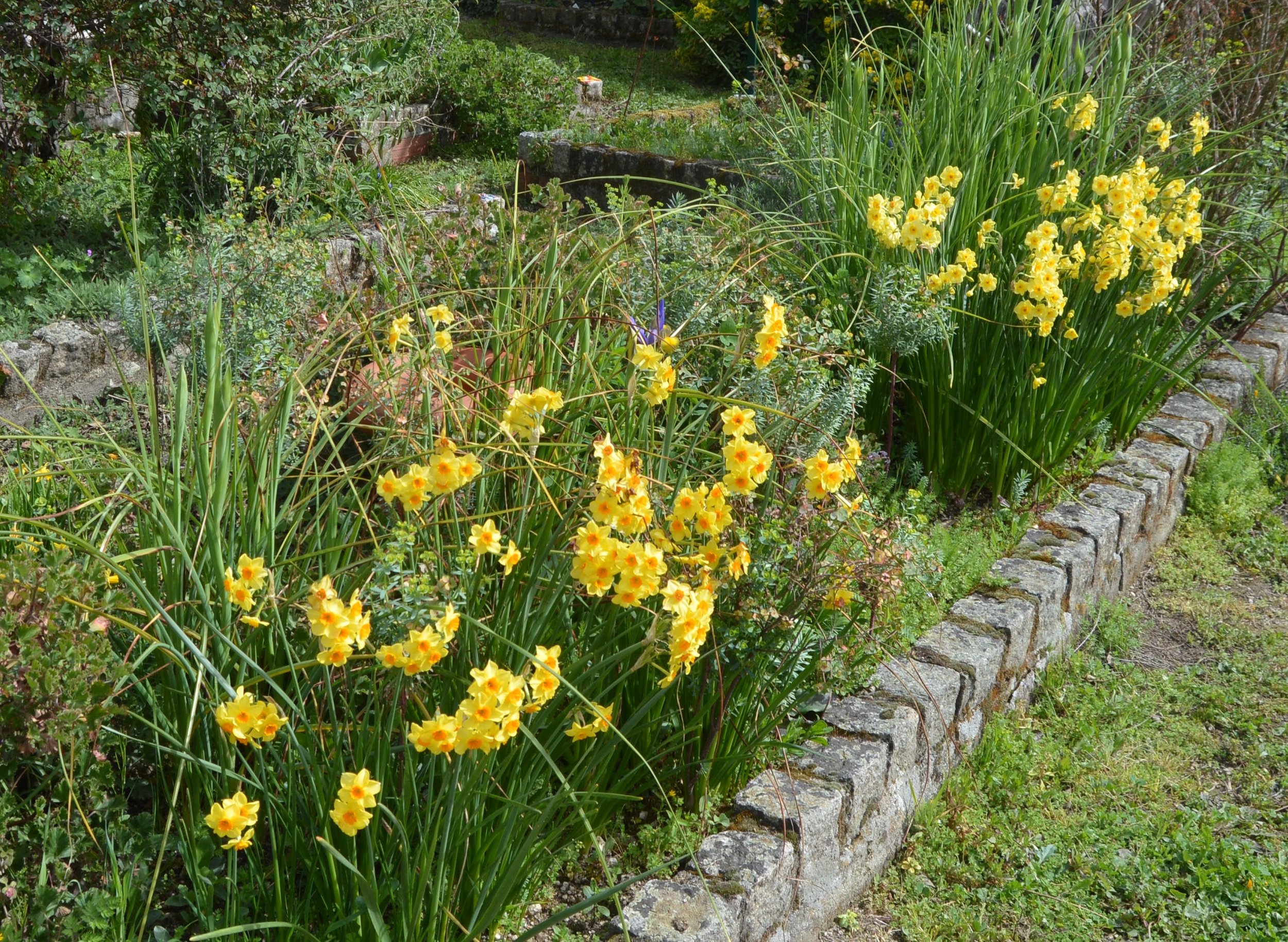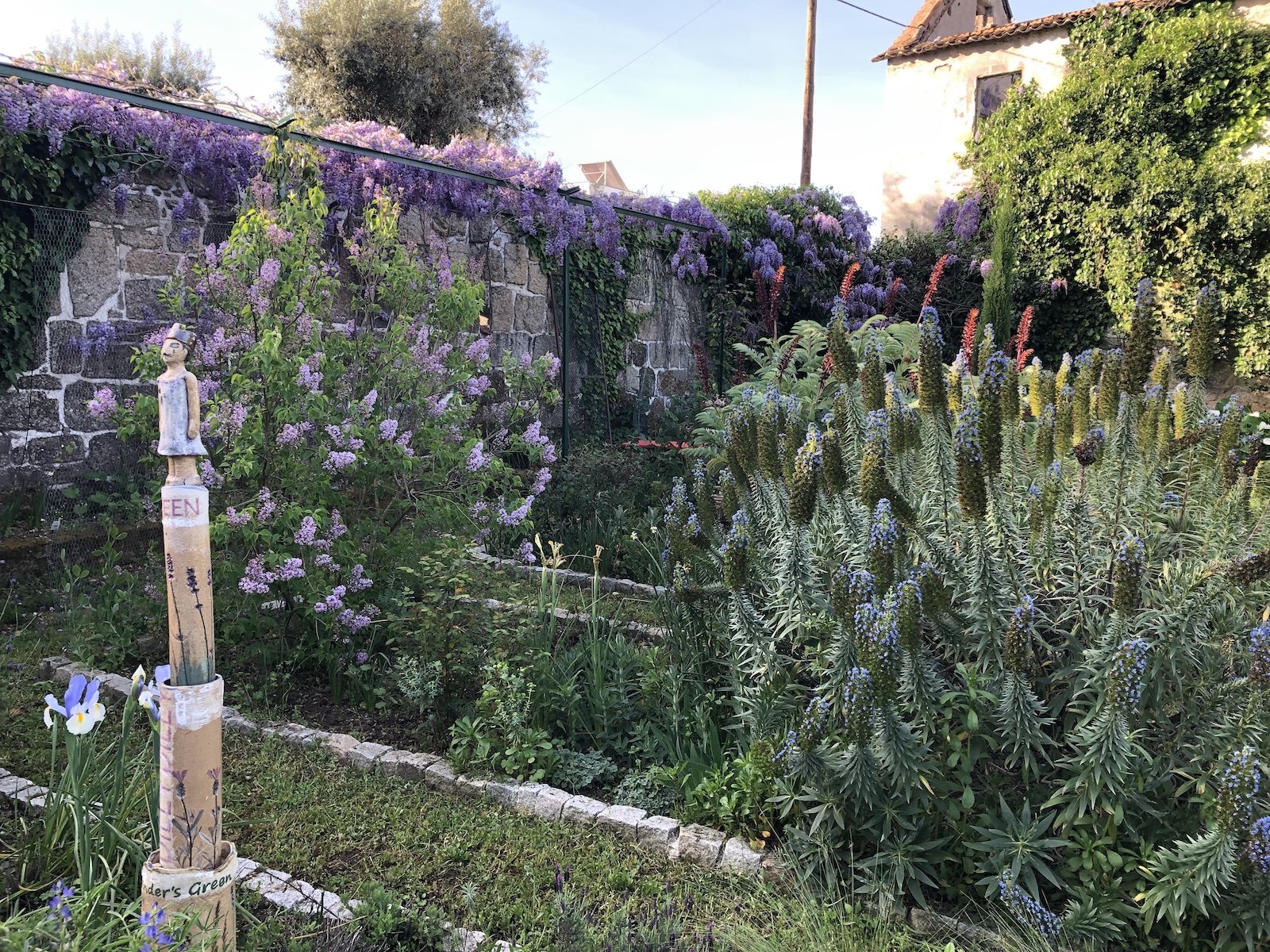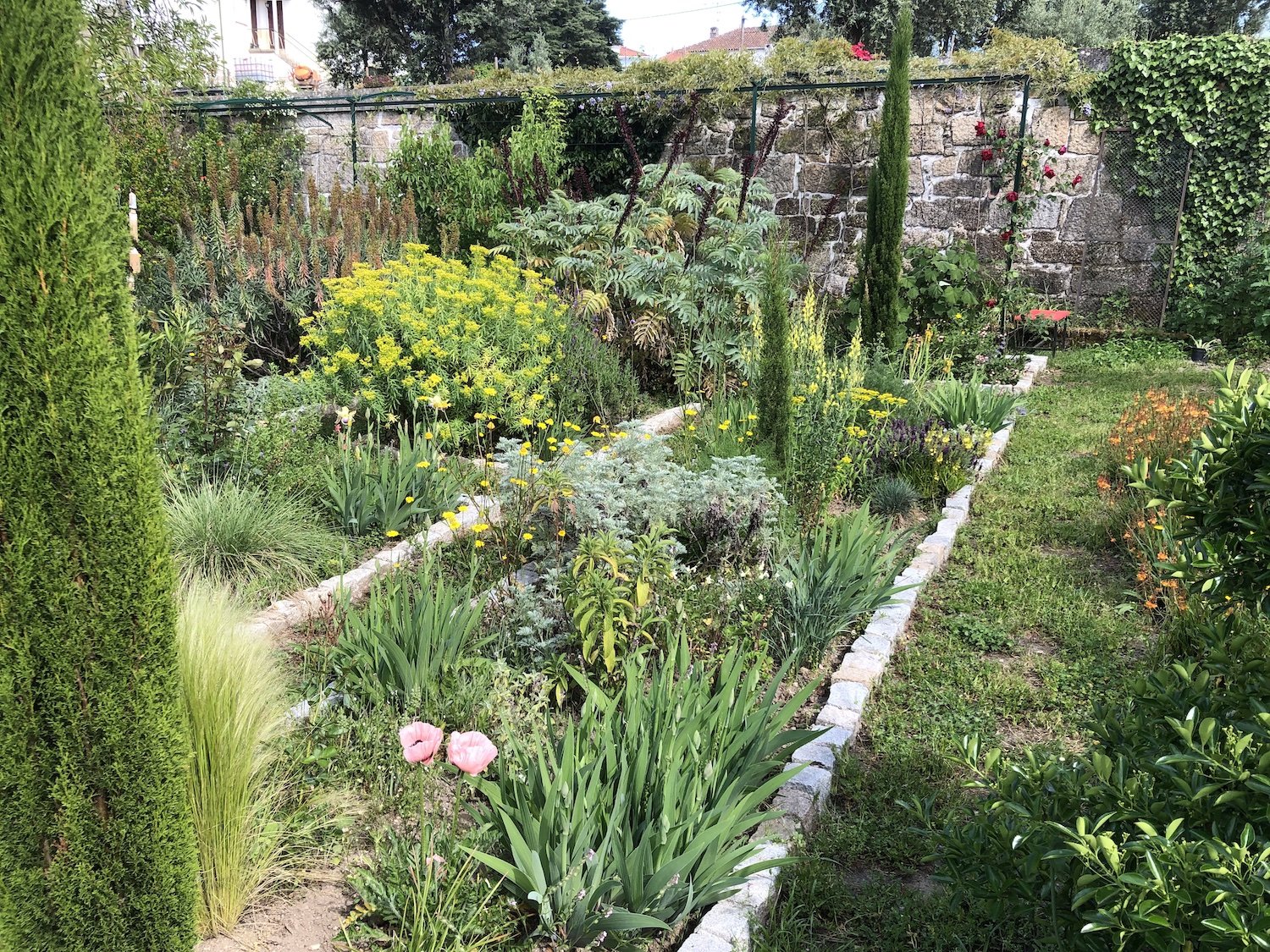Iris ‘Lorelei’ , inherited from previous garden with Linaria genistifolia, one of the real drought-resilient successes here.
It's raining in Vila Nova de Oliveirinha! According to the weather app anyway (as I'm writing this from Berlin). Such good news, as we had almost given up hope of getting any more this spring. We got lots and lots pre-Christmas but very little since and the soil (when we left last week) was like grey dust. I had been dreading something like this.
Lychnis coronaria intermingled with Stachys germanica, the latter a reliable locally-native perennial, like a chunkier version of S.byzantina.
Growing things successfully in a Mediterranean climate without irrigation (or at least minimising it) means having to rely on two phases in the year where there has to be a conjunction of temperature and moisture. I've discussed this before in previous postings. September, October when the first autumn rains hit warm ground sees incredible growth, and is when most seeds germinate. Annual (and most vegetable growth) seeds germinate now and make terrific growth, rooting in well until a winter slow-down and then speeding up again in the spring. Perennials and sub-shrubs do the same but more slowly, but doing this in containers over the winter for spring planting creates various problems – they do not root in so quickly, and it is often difficult to provide the shade cover they might have in nature. A reasonably wet spring and they will establish, a dry spring and they simply don't, and given how free-draining our soil is, watering does little to help. A dry spring then means very poor conditions for establishing new plantings and puts a lot of stress on the spring growth of things planted the previous year.
Most divisions of daffodils do well, but tazettas the best of all: ‘Falcoonet’, left, and ‘Martinette’ right.
A very dry December to April period has been very problematic for many bulbs too, and this has thrown up a very interesting surprise. I have always thought of tulips and (big) alliums as plants from dry habitats and regions (eastern Mediterranean, Middle East, Central Asia) and Narcissus as being from the relatively high winter rainfall western Mediterranean. So it surprised me to see how daffodils have been more or less unaffected by the late winter-spring drought but tulips, alliums and Iris x hollandica have been suffering terribly. I suppose the answer must lie in length of growing season; narcissus have a long growing season (root growth in autumn) and so can take advantage of moisture over a longer period, the others have shorter, more temperature-dependent growing season which naturally would benefit from snow melt or some guaranteed spring source of water. No water for them at a crucial time and they really suffer - brown leaves, or just very poor growth, stunted flowering, so less resilience – interesting!
An ancient wisteria has a new home on a pergola, along with a rather nondescript syringa, Echium candicans (going over fast, as they do); sculpture by Bristol artist Deborah Weymont.
This year's late spring rain will I hope, offer a lifeline to things I have planted out in January and February – mostly native sub-shrubs in forestry plugs (alveolas florestais). These I had grown from seed sown autumn 2021, kept watered through last summer, and either planted out in October or very early this year. Autumn plantings (mostly native Lavandula stoechas – confusingly rosmarinho in Portuguese) look fine – they have been growing. Later ones: lavenders and Phlomis fruticosa, Ruta graveolens, I have been more worried about, as they have not grown at all this spring.
The inevitable Stipa tenuissima (left) shows no sign of either dying or seeding. Here, with various Mediterranean shrubs. Will it still be here in two years time?
Grasses are particularly problematic about timing. I grew some Stipa gigantea (the garden's 'theme plant' and a local native) from seed last year; a few in plugs but they stayed quite small and the rest I planted out in a nursery bed. Grasses, notoriously, don't like disturbance when they are not actively growing, so the transplants I did in February, when they were not actively growing, have nearly all died, whereas the ones I did in early April (actively growing) have been ok, but only because I have watered them – something I have little patience with as it involves dragging hoses across considerable lengths of rough ground. In previous years, quite big divisions from plants dug up from the landscape, have taken well at this time whereas carefully taken divisions in winter were a disaster.
Euphorbia sarwschanica does well here, as do many Euphorbia. Melianthus major too, although this year they are flowering and seeding several months earlier than last and I fear will be summer/drought dormant. Papaver orientale ‘Königin Charlotte’ in front, not establishing well - indeed one of the interesting things here is how slowly (or badly) many perennials establish, all ones from drought or short-growth season regions; don’t really understand why yet. Orange Bulbine frutescens on the right, unkilleable, utterly durable, a useful low evergreen.
Bupleurum fruticosum has continued to be the wonder shrub, a native understorey shrub of the Alentejo (south, hot) but fine in full sun here. Never watered, now forming substantial shrubs, they are however beginning to fall apart, and so beginning to look a bit of a mess. The great thing about this is that it will take hard pruning (most Mediterranean shrubs don't) and so come the autumn, that's what I am going to do. This is one of those plants that is almost impossible to propagate; cuttings don't root and seed, however fresh, does not germinate. Seedlings do appear below the shrubs however and so if you get down on hands and knees it is possible to dig them up, pot them on and plant them out at a conveniently wet time of year. Another understorey shrub that flourishes in full sun is Viburnum tinus, and that's another difficult one to propagate – I recommend picking vast quantities of berries, soaking and washing over several weeks and then sowing – but expect a germination rate of 1%, with nothing the year after.
What is known as 'Portuguese' laurel, Prunus lusitanica, is not however one for full sun, as it get's horribly scorched. I wondered aloud to a landscape historian once about why it is so rare in the country for which it has its English name, and he suggested that it has been effectively driven to extinction by shepherds over many centuries, as it poisons stock. Never romanticise traditional agricultural practices! which here, as over much of the Mediterranean, have done huge damage to the landscape.
I must admit I am not looking forward to the summer. If it is like last year, it will be hotter than the norm, and a real test for the garden. Hopefully the late rain we are having will help with survival.
Rumex acetosella (Sheep sorrel), a typical weed of acid soils, a menace in the veg garden or amongst new plantings (one of the rare occasions I now reach for the Roundup) but in established plantings is ok to let wander and can be very atractive in the right light, here with Artemisia ludoviciana, a steppe species which has done really well.






